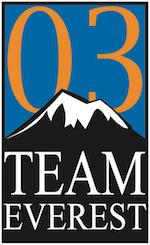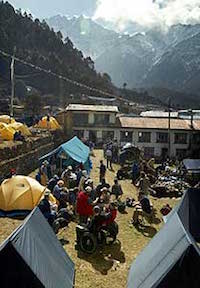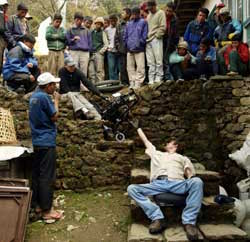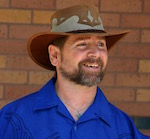Team Everest Anniversary Post #3: Getting Acclimatized and Acquainted
Gene Rodgers
May 16, 2017
To commemorate the 14th anniversary of CTD's Team Everest '03 Expedition, trekker and long-time CTD member Gene Rodgers shares his memories of the event in a series of guest blog posts. Check in Tuesdays in May for new posts!
 We stayed in Kathmandu for several days to acclimatize, or get used to the higher elevation and thinner air.
We stayed in Kathmandu for several days to acclimatize, or get used to the higher elevation and thinner air.
We were sure to attract attention wherever we went. Many Nepalese had never seen a person with a severe disability, especially at that elevation. As in most lesser developed countries, if someone becomes paralyzed, they’re likely to die. If they survive, they’re likely to be stuck at home because there’s no real wheelchair accessibility. Children born with a mobility impairment are also kept at home or are institutionalized.
During our daily forays into Kathmandu, I became acquainted with some of my fellow trekkers. Mark (or deaf Mark as I called him to distinguish him from wheelchair Mark) and his interpreter Christine worked at the Texas School for the Deaf in Austin and had a great fascination with Mount Everest. Unfortunately, when we learned that the Iraq War had started, deaf Mark dropped out of the trek to go home to his wife.
Matt, at 24, was one of the youngest trekkers. He became a paraplegic during an accident only a few years earlier. Matt worked at Wal-Mart, loved sports, and had boundless enthusiasm. Then, there was Riley who was a few years older than Matt and had broken his back in a skiing accident while attending West Point. He never shied away from a challenge.
On one outing, Matt noticed a narrow alley, lined by brick walls with a significant downward slope. Matt’s eyes lit up and, while popping a wheelie, he rolled up to Riley. “What do you think?” he asked while motioning toward the alley with his head.
They both lined up at the top of the alley, tipped their chairs back, and took off. Matt quickly built up speed and moved out front. Riley unsuccessfully followed Matt’s lead. He clipped the wall on his right, pinched his hand, let the wheel go, and crashed into the wall. Everyone gasped as he spilled out of his chair. Riley was uninjured except for his pride. Still, one of the Sherpa scolded the rest of us for letting it happen.
After leaving Kathmandu, Matt and Riley’s activities slowed down to what they thought was a safer pace.
--
 After several days in Kathmandu, we took an early morning flight to Lukla (9,184ft), a small village and the trailhead into the Khumbu region. On the airplane, several seats were removed to make spots for those in wheelchairs. This made boarding far more comfortable because we didn’t have to be manhandled by well-meaning but inexperienced helpers. Only two people in wheelchairs fit side-by-side, then everyone else filled in the gaps. We were packed in like sardines, but every face in the plane was a happy one.
After several days in Kathmandu, we took an early morning flight to Lukla (9,184ft), a small village and the trailhead into the Khumbu region. On the airplane, several seats were removed to make spots for those in wheelchairs. This made boarding far more comfortable because we didn’t have to be manhandled by well-meaning but inexperienced helpers. Only two people in wheelchairs fit side-by-side, then everyone else filled in the gaps. We were packed in like sardines, but every face in the plane was a happy one.
The real adventure started at the Lukla airport – the most dangerous airport in the world. It has a very short, narrow runway and is nestled between several mountains. If we went off the runway, we would roll off the mountain.
--
Once we arrived and set up our tents (right), Riley and Matt decided to look around. There were steps everywhere, and the Sherpa wanted to help them, but the pair insisted on making their own way. The Sherpa were, understandably, concerned.
 To begin their exploration, Matt got out of his chair and scooted down some steps. Riley got out of his chair, took the rear wheels off both chairs and handed them down to Matt (left). They continued down the steps in this fashion until they reached the bottom, reassembled their chairs, and acted as if it was an ordinary day. They made their way around town and back up the steps. Because their bodies weren’t yet acclimatized to the elevation, they paid dearly for it the next morning with headaches, nausea, and fatigue. As a former visitor to Nepal, I saw this coming, but knew nothing that I said would have stopped them. Besides, it made a statement about our willingness and persistence to accomplish our task.
To begin their exploration, Matt got out of his chair and scooted down some steps. Riley got out of his chair, took the rear wheels off both chairs and handed them down to Matt (left). They continued down the steps in this fashion until they reached the bottom, reassembled their chairs, and acted as if it was an ordinary day. They made their way around town and back up the steps. Because their bodies weren’t yet acclimatized to the elevation, they paid dearly for it the next morning with headaches, nausea, and fatigue. As a former visitor to Nepal, I saw this coming, but knew nothing that I said would have stopped them. Besides, it made a statement about our willingness and persistence to accomplish our task.
Meanwhile, I got re-acquainted with Tsering Sherpa. When we met during my first trip to Nepal, he amazed me with his situational awareness, so I was very pleased to see him again.
Read Post #4: Getting Closer to Base Camp
Photos by Erich Schlegel, The Dallas Morning News.
About Gene
 Adventurer, activist, media star, and educator Gene Rodgers earned a bachelors degree in Education, an MBA, and graduate and post-graduate studies in rehabilitation. He has traveled in 44 countries, on six continents, and a number of island nations. He has enjoyed recreational activities and adventure sports including skydiving, sailing, paragliding, scuba diving, and, of course, trekking in the Himalayas. To to share his experiences, Gene created the TV/Web show “The Gene And Dave Show” with Dave Dauber. View the award winning show on Access Austin or TheGeneAndDaveShow.com. Gene is a long-time member of CTD and ADAPT of Texas.
Adventurer, activist, media star, and educator Gene Rodgers earned a bachelors degree in Education, an MBA, and graduate and post-graduate studies in rehabilitation. He has traveled in 44 countries, on six continents, and a number of island nations. He has enjoyed recreational activities and adventure sports including skydiving, sailing, paragliding, scuba diving, and, of course, trekking in the Himalayas. To to share his experiences, Gene created the TV/Web show “The Gene And Dave Show” with Dave Dauber. View the award winning show on Access Austin or TheGeneAndDaveShow.com. Gene is a long-time member of CTD and ADAPT of Texas.


